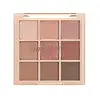What's inside
What's inside
 Key Ingredients
Key Ingredients

 Benefits
Benefits

 Concerns
Concerns

 Ingredients Side-by-side
Ingredients Side-by-side

Talc
AbrasiveMica
Cosmetic ColorantBoron Nitride
AbsorbentSilica
AbrasiveNylon-12
CI 77891
Cosmetic ColorantOctyldodecyl Stearoyl Stearate
EmollientCaprylic/Capric Triglyceride
MaskingPhenyl Trimethicone
Skin ConditioningDiisostearyl Malate
EmollientMagnesium Stearate
Cosmetic ColorantDipentaerythrityl Hexahydroxystearate/Hexastearate/Hexarosinate
Skin ConditioningCI 77492
Cosmetic ColorantTriethoxycaprylylsilane
1,2-Hexanediol
Skin ConditioningDimethicone
EmollientMethicone
EmollientCI 77491
Cosmetic ColorantGlyceryl Caprylate
EmollientHydrogenated Lecithin
EmulsifyingCI 77499
Cosmetic ColorantStearyl Dimethicone
EmollientCI 73360
Cosmetic ColorantSimmondsia Chinensis Seed Oil
EmollientSynthetic Fluorphlogopite
Vegetable Oil
Skin ConditioningHexyl Laurate
EmollientHdi/Trimethylol Hexyllactone Crosspolymer
CI 77007
Cosmetic ColorantCI 77742
Cosmetic ColorantMagnesium/Potassium/Silicon/Fluoride/Hydroxide/Oxide
Isopropyl Titanium Triisostearate
EmollientMyristic Acid
CleansingTin Oxide
AbrasiveCalcium Aluminum Borosilicate
Calcium Titanium Borosilicate
AbrasivePolymethyl Methacrylate
Butylene Glycol Dicaprylate/Dicaprate
EmollientEthylene/Acrylic Acid Copolymer
Emulsion StabilisingPolypropylene
Dimethicone/Vinyl Dimethicone Crosspolymer
Skin ConditioningLauroyl Lysine
Skin ConditioningTalc, Mica, Boron Nitride, Silica, Nylon-12, CI 77891, Octyldodecyl Stearoyl Stearate, Caprylic/Capric Triglyceride, Phenyl Trimethicone, Diisostearyl Malate, Magnesium Stearate, Dipentaerythrityl Hexahydroxystearate/Hexastearate/Hexarosinate, CI 77492, Triethoxycaprylylsilane, 1,2-Hexanediol, Dimethicone, Methicone, CI 77491, Glyceryl Caprylate, Hydrogenated Lecithin, CI 77499, Stearyl Dimethicone, CI 73360, Simmondsia Chinensis Seed Oil, Synthetic Fluorphlogopite, Vegetable Oil, Hexyl Laurate, Hdi/Trimethylol Hexyllactone Crosspolymer, CI 77007, CI 77742, Magnesium/Potassium/Silicon/Fluoride/Hydroxide/Oxide, Isopropyl Titanium Triisostearate, Myristic Acid, Tin Oxide, Calcium Aluminum Borosilicate, Calcium Titanium Borosilicate, Polymethyl Methacrylate, Butylene Glycol Dicaprylate/Dicaprate, Ethylene/Acrylic Acid Copolymer, Polypropylene, Dimethicone/Vinyl Dimethicone Crosspolymer, Lauroyl Lysine
Mica
Cosmetic ColorantEthylhexyl Polyhydroxystearate
EmollientDimethicone
EmollientTriethoxycaprylylsilane
Caprylyl Glycol
EmollientPhenoxyethanol
PreservativeHexylene Glycol
EmulsifyingSynthetic Fluorphlogopite
Pentaerythrityl Tetraisostearate
EmollientOctyldodecyl Stearoyl Stearate
EmollientMagnesium Myristate
Silica
AbrasiveTin Oxide
AbrasiveCI 77007
Cosmetic ColorantCI 77499
Cosmetic ColorantKaolin
AbrasiveCI 77491
Cosmetic ColorantIngredients Explained
These ingredients are found in both products.
Ingredients higher up in an ingredient list are typically present in a larger amount.
This pigment is called Ultramarine blue lazurite. It gives a saturated blue color, but can be used to create other colors as well.
According to the manufacturer, it is usually made from kaolin, sodium sulfate, sodium carbonate, sulfur, and charcoal.
Ci 77491 is also hydrated iron III oxide. It's sole purpose is to give a red/pink hue to products.
Iron III oxides are classified as inorganic chemicals for coloring.
Synthetically created Ci 77491 is considered safer than those naturally found. This is because the synthetically created version may contain less impurities. Iron oxides are generally non-toxic and non-allergenic.
Learn more about CI 77491Ci 77499 is also hydrated iron III oxide. It is created from mixing red and black iron oxides. This helps give shades of darkness to a product.
Iron III oxides are classified as inorganic chemicals for coloring.
Dimethicone is a type of synthetic silicone created from natural materials such as quartz.
What it does:
Dimethicone comes in different viscosities:
Depending on the viscosity, dimethicone has different properties.
Ingredients lists don't always show which type is used, so we recommend reaching out to the brand if you have questions about the viscosity.
This ingredient is unlikely to cause irritation because it does not get absorbed into skin. However, people with silicone allergies should be careful about using this ingredient.
Note: Dimethicone may contribute to pilling. This is because it is not oil or water soluble, so pilling may occur when layered with products. When mixed with heavy oils in a formula, the outcome is also quite greasy.
Learn more about DimethiconeMica is a naturally occurring mineral used to add shimmer and color in cosmetics. It can also help improve the texture of a product or give it an opaque, white/silver color.
Serecite is the name for very fine but ragged grains of mica.
This ingredient is often coated with metal oxides like titanium dioxide. Trace amounts of heavy metals may be found in mica, but these metals are not harmful in our personal products.
Mica has been used since prehistoric times throughout the world. Ancient Egyptian, Indian, Greek, Roman, Aztec, and Chinese civilizations have used mica.
Learn more about MicaOctyldodecyl Stearoyl Stearate is created from stearic acid.
It is an emollient and thickens the lipid (oil) portion of a product. Due to its emollient properties, it may not be fungal-acne safe.
Silica, also known as silicon dioxide, is a naturally occurring mineral. It is used as a fine, spherical, and porous powder in cosmetics.
Though it has exfoliant properties, the function of silica varies depending on the product.
The unique structure of silica enhances the spreadability and adds smoothness, making it a great texture enhancer.
It is also used as an active carrier, emulsifier, and mattifier due to its ability to absorb excess oil.
In some products, tiny microneedles called spicules are made from silica or hydrolyzed sponge. When you rub them in, they lightly polish away dead skin layers and enhance the penetration of active ingredients.
Learn more about SilicaSynthetic Fluorphlogopite is the synthethic version of mica. It consists of fluorine, aluminum and silicate.
Synthetic Fluorphlogopite is used to add volume to products.
It is considered non-irritating on the skin.
Learn more about Synthetic FluorphlogopiteTin Oxide is an inorganic oxide used to add opacity and volume to a product. In nature, it is already found in mineral form. The main ore of tin is an opaque and shiny mineral called casseterite.
Tin Oxide helps remove translucency in a product, or make it more opaque. Besides adding opacity, tin oxide is used for bulking to add volume.
Triethoxycaprylylsilane is a silicone used to bind and stabilize ingredients.
As an emulsifier, it helps prevent ingredients from separating. This can help elongate the shelf life of products.
Triethoxycaprylylsilane is often used to coat mineral sunscreens ingredients to help give a better feel. It also helps reduce oxidative stress in sunscreens.
Learn more about Triethoxycaprylylsilane